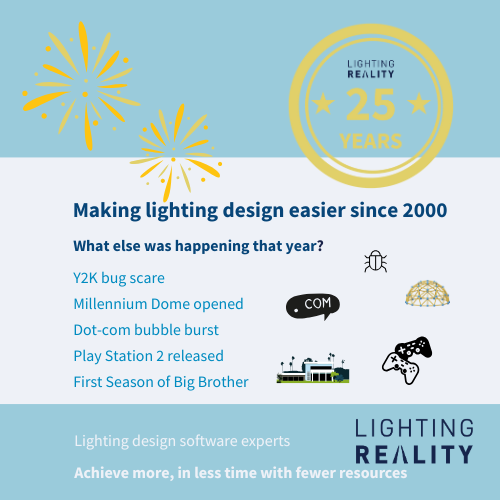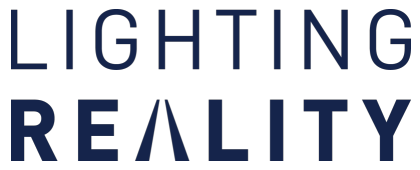
Lighting Reality was started in 2000, the same year as the Y2K bug scare, the dot-com bubble burst and the release of Play Station 2..
Our Technical Support Manager, Kevin Kelly has been part of the company since the very beginning. We thought we’d ask him some questions about the Lighting Reality heritage and development:
Kevin, do you remember the original Lighting Reality Mission Statement?
Initially, the ambition was to offer the industry an independent commercial software for Road and Area calculations, as up till then the programs were the domain of manufacturers of lighting equipment.
To attract users, we also needed an innovation, and we conceived the “Real-Time” calculation process. Phrases such as “Ditch the Calculate button”, “Real-time design”, “independent” and “quick, easy and simple” spring to mind.
Not much has changed over the years, in terms of our Mission.
Lighting Reality has always been focused on writing software to make the lighting designers job more efficient. That is still what we strive to do today and pledge to continue to do going forward.
How has technology changed over the last 25 years?
Real-time calculations in Outdoor and the Optimise routine in roadway, are the key technologies, in terms of core functionality. These are still relevant today and have not yet been rivalled.
The main changes have been in the software delivery and updates, going from physical CDs, DVDs and thumb drives (physically burning the discs, printing labels packaging and posting in batches of 150 until the entire userbase was served), to the current IDS (internet delivery system) for online distribution and licence management.
The next step is the SaaS cloud-based implementation LR STUDIO, removing all the administration of installation, delivery and updates. This will also make Lighting Reality software licences truly mobile, following the User to wherever they sign in to their individual account.
Updates will automatically be applied too, so you will always be signing in to work on the latest and best version of Lighting Reality.
How have the needs of Lighting Specifiers changed over the years and how has Lighting Reality evolved to meet those needs?
Initially being able to perform calculations that were quick and accurate was the key, along with proven standards compliance to BS5489: 1992.
This moved on through the S/P ratios style of design (2006-2015) and our software development has followed design trends. One example is the optimise functions, which became essential for LED mass re-lighting and PFI schemes of the last 15 years.
Most recently the essence of EN13201:2015 and BS5489:2020 with more emphasis on energy performance criteria, TI in residential design and facial recognition.
In parallel with these developments, are the American RP8 and the Aus / NZ 1158 standards and design capability.
Finally, any predictions for the future of lighting design and lighting design software?
Going forward one of the challenges for lighting designers, will be to not ‘over light’ areas, instead producing schemes with just enough light, no more no less. The focus will be on light control, with no spill or obtrusive light.
More 3D modelling and CAD interaction will be required, along with the ability to perform Glare calculations and introduce solid or translucent surfaces into the model.
The Lighting Impact Assessments (LIA) require these abilities, and they will eventually become mandatory in all markets. The EU have adopted much of this already and the UK through ILP/CIBSE/SLL/CPRE/IDA are pushing hard for this to be, if not mandated, then enforced by planning.
Thank you Kevin, here’s to the next 25 years of Lighting Reality software!
To keep up to date with development news and all new photometry added to Lighting Reality, click HERE.
Follow Lighting Reality on LinkedIN.

